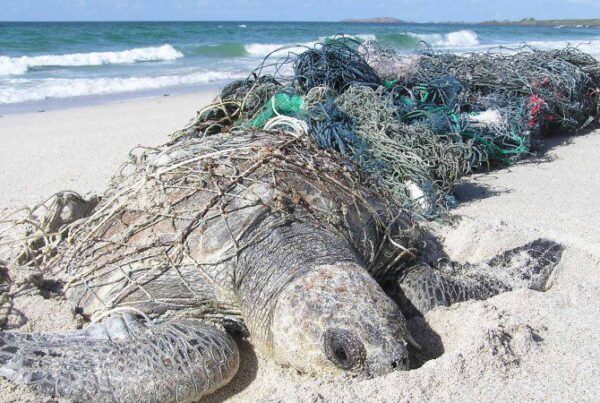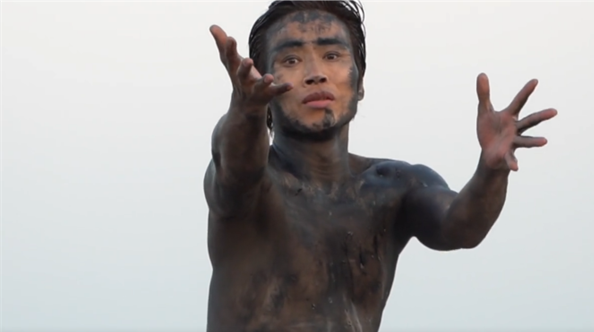I returned home on a ship after completing an interview assignment. As the ship approached the Taiwan Strait, I was woken up by passengers who got up early to watch the sunrise. After washing up, I stepped out on deck for a walk.
The stars were hidden, the fog gone, the sky was a lovely blue connecting with the water, and the sea was as blue as a sapphire. Not long after, the eastern sky dawned. The red sun quietly peeked out from behind the clouds with a smiling face, shedding ten thousand golden lights over the calm sea, like ten million golden fish in the happy jumping.
How beautiful! The motherland’s ocean.
“Look, what is that?” A young girl shouted.
I curiously turned my head and looked in the direction of the girl’s finger. I saw that on the north side of the sea, an ink-black water column emerged, and soon it spread out over the sea, like a brightly coloured “black peony.”
People on the deck were talking about it. Some said that it was a tsunami and that there must have been an earthquake on the seabed; some said that it might have been some kind of explosive test on the seabed…

What on earth is this? I, too, was baffled by this sudden and strange sight. We went to ask our captain, who had more than 40 years of sailing experience, but he could not answer us either. It was a mystery. Throughout the course of the voyage, I kept wrestling with the puzzle, determined to solve it.
When I returned to the newspaper office, I saw the director of the interview department write down the newly assigned task given to me in notepad, and I couldn’t help shouting with joy: “The answer to the riddle is about to be found!”
During the afternoon of the same day, I carried out the new task given to me by the director and visited the joint office of the Ministry of Geology and the Ministry of Industry. When I explained my intention to the comrade who received me, he immediately accompanied me to the special solar helicopter. In less than three quarters of an hour, the solar helicopter landed on a ship in the East China Sea.
Just after getting off the plane, someone came over to greet me.
“Ding, as expected of a journalist, you’re really well-informed!
I looked up and saw, hey, isn’t this Xiao Di, who studied with me at the same table in secondary school? I never thought we would meet here. I shook his hand for a long time, holding it tightly, and I couldn’t describe how happy we were at that moment.
“Let’s go in and talk!” He enthusiastically pulled me into the parlour.
As soon as I sat down, I asked anxiously:
“Some years ago, I heard that you worked in the Northwestern geological exploration team. How all of a sudden did you change your profession to the sea?”
“Hah, no, I still engage in exploration!” Xiao Di smiled and said, “It is always coarsely assumed that mining minerals means finding underground deposits, as if there were no other places to look for them.”
He continues, “In terms of the oil stored on the seabed alone, it hasn’t been very well exploited yet. The offshore has been mined, but what about the deep seas? We’re just getting started.”
“And for that, you’ve shifted your position to the deep ocean floor?”
Xiao Di answered me with a proud look: “Yes, we have made a detailed study based on the information provided by the resource satellite and selected several sea areas for drilling. As you know, in shallow waters of about two hundred metres, oil can be tapped by constructing surface platforms. This is done by letting rigs drill directly into the seabed rocks. However, it is much harder to extract oil from the seabed at a depth of five or six hundred metres because storms will hinder our drilling. What should we do? Are we just giving up this deposit in the deep sea? No, we must extract oil from it. So we have studied and tried, and now we have drilled successfully – oil is coming out…”
“Was it successful early this morning?” I asked, interrupting him.
“How do you know?” he asked in an astonished tone.
So I described to him the spectacle I had seen this morning.
“It’s because the pipeline wasn’t installed properly: that’s why crude oil bubbled up to the surface,” Xiao said. Now, the mystery of the “Black Peony” has been revealed.
My curiosity is piqued by deep-sea drilling. A smile spread across his face as he stood up:
“Dear comrade reporter, don’t be in a hurry, please go down to the bottom of the sea and investigate yourself. Then you will understand. Just as we were talking, Xiao Di changed into a special costume for me, and accompanied me on the “Seabed Miner” submarine to the bottom of the sea.
At approximately 500 metres deep, the submarine came to a halt.
Suddenly, a tank-type automatic drilling machine, placed at the bottom of the sea, appeared on the television screen when Xiao Di turned on the laser television. He told me: This type of automatic drilling machine is remote-controlled. Put into the seabed, it only needs to be controlled on the boat to drill automatically. Therefore, our submarine becomes a workstation. The drilling machine is connected to an oil pipeline, through which oil can be sent to an undersea refinery. If the pipeline is connected to the shore, the oil will flow to the shore refinery.
“Look!” Xiao said and pressed the electric button, then the automatic drilling machine drove to the bottom of the sea as indicated. Upon pressing another button, the drilling machine automatically began to work. All this was clearly visible on the television screen.
On the face of it, drilling on the seabed does not seem to be that complicated or remarkable. However, it was difficult to imagine how much effort went into designing the automatic drilling machine and starting drilling. Under water, the pressure increases with depth. Therefore, deep-sea drilling requires much greater design and execution than a land-based approach. After repeated studies, they finally created a way to use a submarine as a workstation and drive a drilling machine to the mine. Immediately after that, problems had to be solved with the technology, tools, and dynamics for deep-sea drilling. Let alone that the design of this tank-type automatic drilling machine was an achievement based on dozens of failures.

I gazed at the automatic drilling rig on the TV screen and suddenly remembered a question – how can the drilled oil be transported to the undersea oil refinery or sent to the shore? I thought about it for a long time and couldn’t come up with a suitable solution, so I brought it up.
“That’s a relatively simple question,” Xiao said, without hesitation.
“Oil is lighter than water, and the pressure of the water layer raises the oil liberated from the undersea crust to the surface. It is this pressure that we utilise to transport the oil by means of a conveyor pipe directly from the seabed to a submarine refinery, or all the way to a refinery on shore, without the need for any other power plant.”
“Are there any submarine refineries nearby?”
“Yes, there is an ST refinery on the deep ocean floor two hundred nautical miles from here.” Xiao gave me a look and said, “If you’re interested, let’s go check it out.”
“That would be a blast!” I said excitedly, “I really want to visit and learn!”
“We’ll leave now and still have time to return to the ship in time for dinner.” With that, he pressed an “ST” button on the automated telephone, and a red bulb lit up. Then he looked at his watch and said into the microphone, “ST, Li, this is Commanding Officer Xiao Di, a journalist wants to visit your refinery, we’ll be arriving at about 15:30.”
After the call, the submarine headed for the sea floor in the northeast direction at full speed.
Our submarine stopped when it was still fifty metres underwater from the ST submarine refinery. A huge semi-circular building appeared in front of us, and I thought this might be the oil refinery.
Where was the refinery gate? While I was guessing, a round pipe with a diameter of about two metres came out from the bottom of the huge semi-circular building. Five minutes later, our submarine slowly approached the tube until the door was close to the mouth of the tube.
After a passage of about twenty metres, we entered the refinery.

Li was keen to take us to her office. There are only a few couches and a writing desk here, the rest is full of precision instruments. From here, we can see how the oil refining process works at the whole plant.

The undersea oil refinery is very large. According to Li, the plant occupies an area of about 200,000 square metres under the sea and is divided into three workshops. There are also three oil storage depots outside the plant. A modern equipment system is used for bringing crude oil into the plant, refining it into petrol and paraffin, and then delivering it to storage depots and transporting it to workstations on the sea surface. There were only thirty managers in the whole plant, working three shifts of ten men each, with a ten-day rotation for shore leave. The managers’ job is mainly to look at the instruments and make regular inspections, which is not quite easy, though the working conditions are excellent.
When Li accompanied us to the workshop, Xiao and I were amazed. It doesn’t look like an oil refinery—the workshop is clean and bright, all kinds of pipes are densely packed, but neat and orderly, without dust. Not only was the air fresh and the temperature moderate, but there wasn’t even a trace of oil smell. Only to see the management personnel sitting in front of the console, watching the instruments on the various colours of the indicator, and occasionally pressing the button to make some adjustments. They are all dressed in white, just like staff in the science laboratory. There is an automatic pedestrian expressway on the ground that connects the office to each workshop. As long as a person steps on this motorised walkway, they can effortlessly walk around every corner of the three workshops within half an hour.
When we returned to the factory director’s office, Li took out fruits and snacks to entertain us. While peeling oranges, I asked, “How could refined oil be sent to the mainland?”
Li said: “It’s not that difficult. We transfer the refined oil to a depot outside the factory and store it. When surface stations need oil, they can just turn on the switch to the submarine depot, and oil will flow out from the oil pipe. It’s practically like a petrol station by the side of the road; as soon as the tanker docks, it connects to the pipe from the reservoir and oil is sent straight to the tanker, filling one boat and then another.”
“How wonderful! This undersea oil refinery.” I couldn’t help but marvel.
Xiao interjected, “This is only the first step in seeking minerals from the seabed. Soon, we are going to exploit the tremendous amount of uranium ore hidden in the seabed miles!”
Yes, mankind has declared war on the oceans. Undersea cities, sea ranches and farms will soon emerge – what a wonderful picture it is!
Original text source and illustrations
Lu, K. (1981). Haishang Hei Mudan (海上黑牡丹, “Black Peony” at Sea), first published in 1960. In Mogui Hai (魔鬼海, Demon Seas), pp. 53-62, first edition. Shanxi Renmin Press, 1981.
Translator: Dongyang Li


